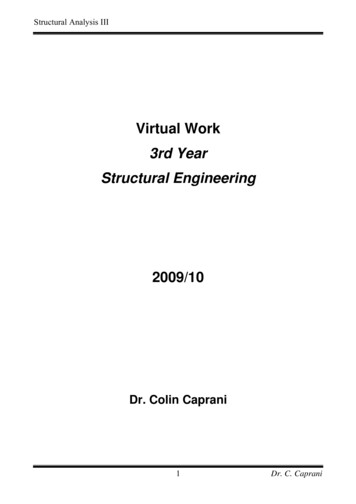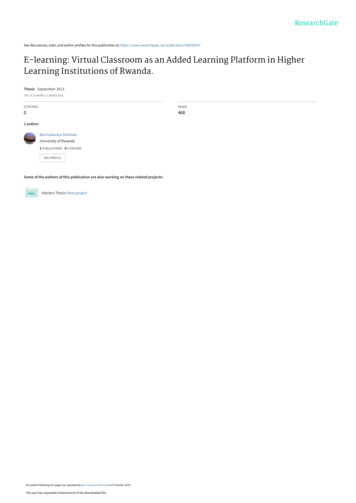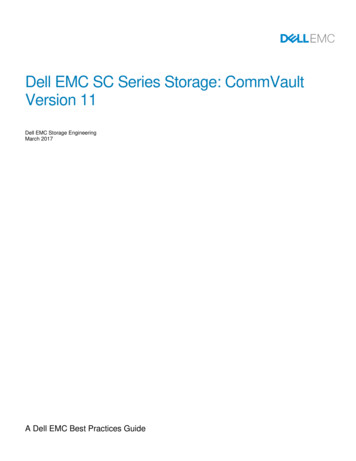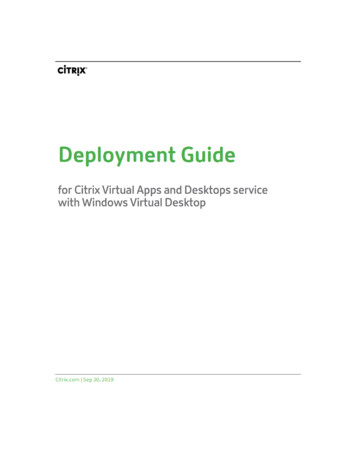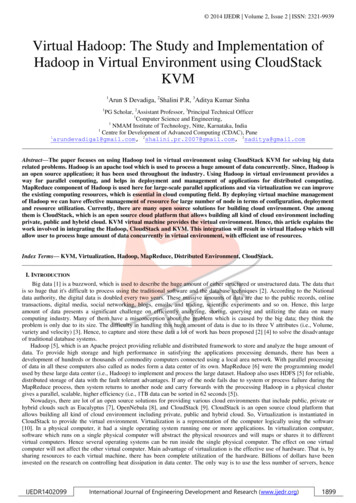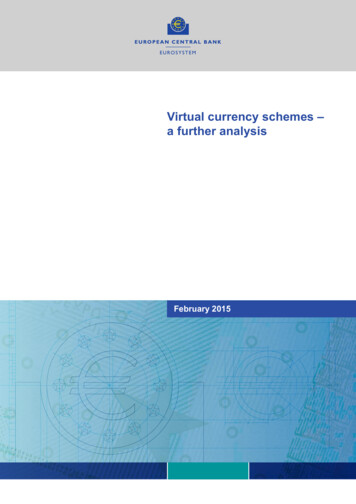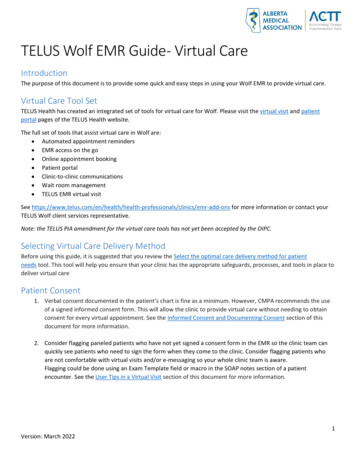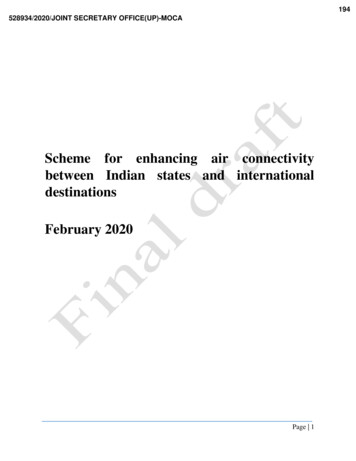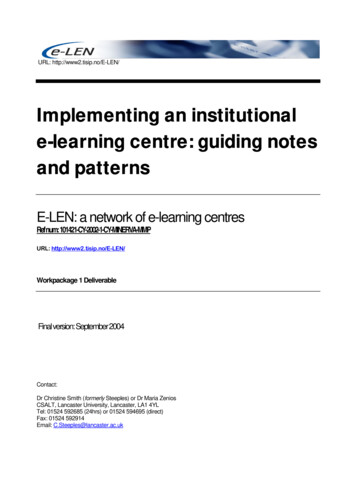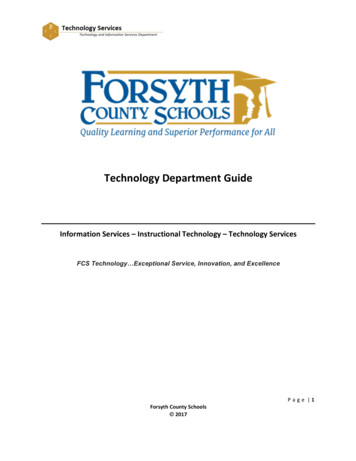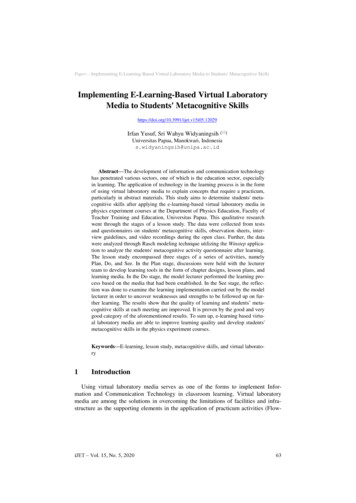
Transcription
Paper—Implementing E-Learning-Based Virtual Laboratory Media to Students' Metacognitive SkillsImplementing E-Learning-Based Virtual LaboratoryMedia to Students' Metacognitive an Yusuf, Sri Wahyu Widyaningsih ( )Universitas Papua, Manokwari, Indonesias.widyaningsih@unipa.ac.idAbstract—The development of information and communication technologyhas penetrated various sectors, one of which is the education sector, especiallyin learning. The application of technology in the learning process is in the formof using virtual laboratory media to explain concepts that require a practicum,particularly in abstract materials. This study aims to determine students' metacognitive skills after applying the e-learning-based virtual laboratory media inphysics experiment courses at the Department of Physics Education, Faculty ofTeacher Training and Education, Universitas Papua. This qualitative researchwent through the stages of a lesson study. The data were collected from testsand questionnaires on students' metacognitive skills, observation sheets, interview guidelines, and video recordings during the open class. Further, the datawere analyzed through Rasch modeling technique utilizing the Winstep application to analyze the students' metacognitive activity questionnaire after learning.The lesson study encompassed three stages of a series of activities, namelyPlan, Do, and See. In the Plan stage, discussions were held with the lecturerteam to develop learning tools in the form of chapter designs, lesson plans, andlearning media. In the Do stage, the model lecturer performed the learning process based on the media that had been established. In the See stage, the reflection was done to examine the learning implementation carried out by the modellecturer in order to uncover weaknesses and strengths to be followed up on further learning. The results show that the quality of learning and students’ metacognitive skills at each meeting are improved. It is proven by the good and verygood category of the aforementioned results. To sum up, e-learning based virtual laboratory media are able to improve learning quality and develop students'metacognitive skills in the physics experiment courses.Keywords—E-learning, lesson study, metacognitive skills, and virtual laboratory1IntroductionUsing virtual laboratory media serves as one of the forms to implement Information and Communication Technology in classroom learning. Virtual laboratorymedia are among the solutions in overcoming the limitations of facilities and infrastructure as the supporting elements in the application of practicum activities (Flow-iJET ‒ Vol. 15, No. 5, 202063
Paper—Implementing E-Learning-Based Virtual Laboratory Media to Students' Metacognitive Skillsers, 2011; Wang, 2018; Yusuf & Subaer, 2013). Practicum activities are essential tobe performed to give a conceptual understanding to students, specifically on physicsmaterial, which consists of everyday life phenomena (Almazaydeh, Younes, & Elleithy, 2016; Maulidah & Prima, 2018; Oidov, Tortogtokh, & Purevdagva, 2012).Students must be provided with a good understanding of the concept.Teachers need to facilitate students to be able to learn. Online learning through elearning can be the right solution to facilitate students in learning whenever and wherever they are (Fauzi, 2017; Sharpe, Rhona & Benfield, 2005; Yusuf, Widyaningsih, &Br.Sebayang, 2018). Currently, online learning can be employed through variousapplications, one of which is the Google Classroom developed by Google as a G Suitefor Education feature released on August 12nd, 2014. Google Classroom is availableonline and free of charge (Madhavi, Mohan, & Didyanalla, 2018), and it presentsmaterials and assignments as well as a means of online discussion. Virtual laboratorymedia can also be packaged into the Google Classroom application, making it easierfor students to access and do experiments virtually. It is expected that using elearning-based virtual laboratory media through the Google Classroom application isable to improve students' ability and understanding of learning, in which it can berealized if they can find out the way of learning.The ability to discover how to learn and understand lessons is called metacognitiveskill (Kallio et al., 2017). Metacognitive skills also play an important role in enhancing the quality of learning outcomes, because metacognition in the learning processhas become the controller and monitor of students' way of thinking (Portilho & Medina, 2016; Tsai, Lin, Hong, & Tai, 2018). Metacognitive knowledge is the knowledgegained by students about cognitive processes, i.e., the knowledge that can be used tocontrol cognitive processes. Metacognition is also related to the comprehension ofhow to reflect, make conclusions, and to be applied in practice (Amin & Mariani,2017).In physics experiment courses, metacognitive skills are related to the skills to solveproblems based on experiments conducted. In problem-solving, students must havethe ability to understand problems, simulate models, perform experimental procedures, and interpret solutions obtained (Ongowo & Indoshi, 2013). In improving theeffectiveness of learning, lesson study activities are conducted to obtain reflectionsand make improvements at each meeting. The main focus of implementing a lessonstudy is the activity of students in the classroom, assuming that the activity is relatedto the teaching activities in the classroom (Saito et al., 2006). Therefore, it is expectedthat using e-learning-based virtual laboratory media through lesson study activities inthe physics experiment courses can enhance students’ metacognitive skills.2MethodThis qualitative research went through the stages of lesson study activities. The lesson study activities consist of three stages of a series of activities, including Plan, Do,and See (Saito et al., 2006). During the Plan stage, there was a discussion with thelecturer team to develop learning tools, such as chapter designs, lesson plans, and64http://www.i-jet.org
Paper—Implementing E-Learning-Based Virtual Laboratory Media to Students' Metacognitive Skillslearning media. Further, in the Do stage, learning is done by the model lecturer basedon the tools that had been prepared. In the See stage, on the other hand, a reflectionwas carried out to study the learning process implemented by the model lecturer toreveal weaknesses and strengths to be followed up in the next learning process.The subjects in this study were students of the Department of Physics Education,Faculty of Teacher Training and Education, Universitas Papua, who programmed 14physics experiment courses. The research data were collected from students' metacognitive skills tests which were given after the learning process, observation sheets,interview guidelines, and video recordings during the open class. The data of metacognition comprised ten open-ended questions and a questionnaire on metacognition.Open-ended questions ware presented in a written form to allow students to expresstheir ideas, cognitive strategies, along with the time and reasons for applying thestrategies. The contents were linked with the concept of modern physics experiments,which were included in a virtual laboratory. The category of students’ metacognitiveskills obtained was based on the open-ended questions, as provided in the followingTable 1 (Riduwan, 2011).Table 1. Student metacognition ability categoryInterval Class81-10061-8041-6021-40 21CategoryVery goodGoodModeratePoorVery poorThe questionnaire of students’ metacognitive skills assessment was based on theindicators of metacognition, as given in Table 2 below (Schraw, 1998). The data ofthe questionnaire regarding students' metacognitive activities after learning were analyzed through the Rasch modeling technique utilizing the Winstep application.Table 2. Indicators and aspects of metacognitive sDescriptionsThinking about how to understand the problemsThinking about reading the problems moreUnderstanding problemsthan onceThinking about how to gain information thatis known and asked by the given problemsThinking about how to model the problemsin the form of imagesThinking about representations andThinking about how to give a notation, arecalling the prerequisite materialsymbol on the image modelingthat can help complete the task.Thinking about the prerequisite conceptswhen reading questionsThe employed problem-solvingRecalling the idea of whether or not thestrategiesproblems had been solved once beforeiJET ‒ Vol. 15, No. 5, 202065
Paper—Implementing E-Learning-Based Virtual Laboratory Media to Students' Metacognitive IndicatorsDescriptionsThinking about how to arrange the steps tosolve the problemsThinking about strategies or different ways tosolve the problemsThinking about checking the suitability of thenotation, the symbol used from the knowninformationThinking about checking the suitability of theprerequisite concept (e.g., the concept of aControlling the implementation of virtual experiment material) used to solve theproblemsproblem-solving activitiesControlling the calculation accuracy step bystepThinking about checking every step of thecompletion and giving a checklist to thesection that has been checked.Thinking about repeating several steps if anImprovement strategy if there is an error occurs.errorThinking about trying another way, if anerror occurs.Thinking about how to check the suitabilityof the answer to the questionThinking about how to re-check the appliedEvaluating the obtained resultsway to ensure that the answers are correct.Re-thinking about whether or not the answersare new.Thinking about whether or not the appliedway can also be applied to other problemsEvaluating the ways/strategiesapplied to solve problemsThinking about other ways that can be usedto solve problems.Results and DiscussionThe application of experimental physics learning is performed through e-learningbased virtual laboratory media, given the limitations of facilities and infrastructure inthe Laboratory of the Department of Physics Education, Universitas Papua. The physics experiment courses consist of modern physics experiments that describe abstractphysics concepts so that students should be given an understanding of doing experiments by using virtual laboratory media.The virtual laboratory media used in physics experiment courses are presented inan integrated form with the e-learning online learning system through the GoogleClassroom application. Teachers can easily create online classes and provide variousmaterials and assignments through the classroom.google.com website address (Joy etal., 2018). Teachers and students can also run online classes on their smartphonesthrough the Google classroom application for Android. Google classroom applicationmakes it easy for students to learn (Heggart, Yoo, & Heggart, 2018). They can accessany lecture completeness, including details of materials, virtual laboratory media,experiment guidelines, or collecting assignments online. Learning to use e-learning66http://www.i-jet.org
Paper—Implementing E-Learning-Based Virtual Laboratory Media to Students' Metacognitive Skillsallows students to learn whenever and wherever they are (Hooks & Casarez, 2018).Figure 1 shows the e-learning-based virtual laboratory media display through theGoogle classroom application.Fig. 1. Display of e-learning consisting of virtual laboratory mediaAt the beginning of the lecture, the model lecturer conveys a general description ofthe material, gives motivation, and apperception about the experiment to be conducted. Students are divided into five groups, and each group consists of three people.They work together in a virtual experiment, as well as retrieves observational data.Figure 2 presents the virtual trial process carried out in groups and their activities inthe online classroom through the Google Classroom application.Fig. 2. Students’ learning activities through virtual laboratory media and through e-learningIn the first experiment, the determination of the e / m ratio, the students regulatethe changes in voltage and electric current, which also cause changes in the radius ofiJET ‒ Vol. 15, No. 5, 202067
Paper—Implementing E-Learning-Based Virtual Laboratory Media to Students' Metacognitive Skillsthe electron beam. Students can determine the spread of the e / m ratio through theobservations obtained. Each group is assigned to record their measurement results andwrite them down on the worksheets that have been provided. Besides, each student isassigned to make an experimental report following the format of research article thatconsists of abstract, introduction, method, results and discussion, conclusions andsuggestions, and references. In the next meeting, group discussions are held. Onegroup presented the results of their experiments. The results show that several measurement values of the e / m ratio that they obtain are not much different from the theory. However, some data are in contrast with the theory. In addition, students discussthe results of their experiments. Some students seem enthusiastic about asking questions and giving answers regarding the problems faced. In the See stage, the determination of the e / m ratio is obtained, in which each group actively does the experiments. They control changes in voltage and electric current, and further see changesin the radius of the electron beam that is formed. Cooperation is very clearly seen,especially the number of members in the group is not large (three people) so that eachstudent in the group can do their job effectively. Nevertheless, several students are nottoo engaged, e.g., student number 2 in group 4. The student still finds it challenging tocontrol the measurand contained in the virtual laboratory media. The model lecturerprovides group guidance to make the students be able to do experiments and to havethe results of observations based on the experiments conducted.During the Millikan oil-drop experiment, students observe the movement of electron particles to determine the charge. They work together on retrieving the data.Some of them control the simulation, calculate the travel time of electron particlemovements, and some record the observations obtained. They are also taking turn indata collection. In this experiment, the data retrieval processes are repeated in orderthat the students need to be forbearing and conscientious. Moreover, in the See stage,it is revealed that most of the students have shown better activities in doing experiments than the previous ones. They also tend to be more cooperative with each otherin collecting data.In the implementation of radioactive activity experiments, students are required tobe more creative since many variables are observed. Students measure the number ofcounts produced by each radiation source to determine its activity and its penetratingpower based on the type of barrier that exists. They also must understand the principleof the experiment because the experimental steps do not accompany the worksheetprovided. Besides, they need to be creative in finding practical ways to get the expected data. In the See stage, it is obtained that students are enthusiastic during thelearning process, involved in the discussions, and can describe their experiments withgreat results.As found in the implementation of learning activities, students are active during thevirtual experiment. Some students take turn in collecting data, controlling responses,doing observations, and recording the experiment results. Collaboration among thestudents during a virtual experiment is well-established (Kurniawan, Mujasam, Yusuf,& Widyaningsih, 2019), because the virtual experimental device encompasses aworksheet that requires students to do experiments creatively, and determines thesteps to be taken to gain the observed data (Kabiri & Wannous, 2018; Wu, 2018;68http://www.i-jet.org
Paper—Implementing E-Learning-Based Virtual Laboratory Media to Students' Metacognitive SkillsYusuf & Widyaningsih, 2019). This condition can encourage students to learn together and to be responsible for the materials in order to achieve common goals. Sharedlearning opens opportunities for them to be more courageous in discussing and beingresponsible in the learning process (Elas, Majid, & Narasuman, 2019; Liu, Li, &Zhang, 2018; Widyaningsih & Yusuf, 2019). Moreover, the reflections at each meeting indicate that the discussions give an excellent academic atmosphere. Some students actively ask questions, and the other answers them. The model lecturer as thelearning facilitator provides opportunities for each student to present the results of theexperiment and analyze the data they have collected.Online learning is also undertaken to facilitate students in accessing materials andexperiencing studying on other platforms besides in the classroom. Discussions arealso available in online classes, where the students enthusiastically ask questions anddiscuss the materials. Online discussions make it much easier for students to haveinformation because they can immediately get the actual answers through discussionsbetween teachers and students (Lee & Martin, 2017), and to give their assignments ontime. Lecturers can directly give scores of students’ assignments, and the students canimmediately see their scores through their accounts (Anthony G. Picciano, 2002).The use of a lesson study in the learning process also has a good impact on improving the learning quality. The model lecturer gains information about the learning atmosphere and condition, so that s/he is able to make an improvement at each meeting(Skultety, Gonzalez, & Vargas, 2017). Lecturers’ teaching professionalism can alsobe enhanced by considering the suggestions and criticisms from various observers,which are then collaboratively and continuously analyzed (Hasanuddin & Akhadiah,2019; Sarimanah, 2018).At the end of each discussion unit, students’ metacognitive skills are assessed. Themeasurement of metacognitive skills is intended to find out their understanding ofeach experiment. Test results for metacognitive skills are shown in Table 3.Table 3. Frequency distribution of students‘ metacognitive skills in every topic of theexperimentsFrequencyInterval Class Determination of e / mCategoryMillikan Oil Drops Radioactive Activitiesratio81-100023Very good61-80121111Good41-60210Moderate21-40000Poor 21000Very ge70,073,675,4SD8,17,37,6Table 3 signifies that students' metacognitive activities have increased in each unitof the experiments performed, proven by the increase in the average values and meta-iJET ‒ Vol. 15, No. 5, 202069
Paper—Implementing E-Learning-Based Virtual Laboratory Media to Students' Metacognitive Skillscognitive assessment categories. In the first experiment, the determination of the e / mratio arrives at an average value of 70.00 SD 8.1, good category. No students reachvery good grades due to the unfamiliarity of such a new learning implementation.Moreover, in the second experiment, the Millikan oil-drop experiment reaches anaverage value of 73.4 SD 7.3, good category. Eventually, there is an increase inmetacognitive skills, by which two students are in a very good category.Similarly, radioactive substance activities as the third experiment get an averagevalue of 75.4 SD 7.6, good category. This experiment also experiences an increasein students' metacognitive skills, where they mostly arrive at good and very goodcategories. The improvement of students' metacognitive skills is shown at each meeting, e.g., they can understand how they can obtain the expected measurement results.Metacognitive skills show students' deep understanding of how they acquireknowledge (Garrison & Akyol, 2015; Lai, Zhu, Chen, & Li, 2015). The skills refer toways to raise awareness about the thinking process in on-going learning. If this is true,then one can begin to think about designing, monitoring, and assessing what s/helearns (Sarimanah, 2016).Assessment of metacognitive skills is done through questionnaire responses to student activities given at the end of the learning activities. The results of the questionnaire can be viewed in the following Figure 3.Fig. 3. Analysis of the assessment of metacognitive activities responsesFigure 3 brings out the fact that on the left side, there are five out of 14 studentswho have a high level of skill, i.e., agree with all statement items in the questionnaire.On the right side, there is one of the most difficult statements to agree, namely S4“thinking about how to model problems in the form of images”. This is caused by the70http://www.i-jet.org
Paper—Implementing E-Learning-Based Virtual Laboratory Media to Students' Metacognitive Skillstrouble faced by the students in analyzing experimental data, and they do not modelthe analysis in the form mentioned previously. This issue can be immediately overcome by utilizing numeric processing programs, such as Excel. Students can instantlyinput the value of the measurand obtained through the experiment, and then enter theequation formulation to obtain the measurand sought.The statement that is mostly agreed by most of the students is S12 “controlling thecalculation accuracy systematically”, indicating that the difficulty they experience inanalyzing data makes them more careful in doing the calculation step by step(Özsoy& Ataman, 2009). On the right side of the map, it is clearly seen that the majority ofthe students agree with the provided statements. Therefore, their metacognitive activities can be developed through learning. Metacognitive activities are related to theresponses of the students who are good at understanding the subject matter (Bol,Campbell, Perez, & Yen, 2016; Richmond, Bacca, Becknell, & Coyle, 2017).4ConclusionThe implementation of e-learning-based virtual laboratory media can improve thelearning quality and students’ metacognitive skills in physics experiment coursesthrough lesson study activities. In the first experiment, the determination of the e / mratio measures at an average value of 70.00 SD 8.1 or good category. In this experiment, no students reach very good grades. Further, in the second experiment, theMillikan oil-drop experiment reaches an average value of 73.4 SD 7.3, good category. Radioactive substance activities as the third experiment, on the other hand, get anaverage value of 75.4 SD 7.6, good category, where the students mostly arrive atgood and very good categories. The questionnaire results regarding metacognitiveactivities signify that the majority of the students have good responses to their learning, and their metacognitive skills can be developed.5References[1] Almazaydeh, L., Younes, I., & Elleithy, K. (2016). An Interactive and Self-InstructionalVirtual Chemistry Laboratory. International Journal of Emerging Technologies in Learning, 11(7), 70–73. https://doi.org/10.3991/ijet.v11i07.5853[2] Amin, I., & Mariani, S. (2017). PME Learning Model : The Conceptual Theoretical Studyof Metacognition Learning in Mathematics Problem Solving Based On Constructivism.IEJME, 12(3), 333–352.[3] Anthony G. Picciano. (2002). Beyond Student Perceptions: Issues of Interaction, Presence,and Performance in an Online Course. Journal of Asynchronous Learning Networks, 6(1),21–40. https://doi.org/10.24059/olj.v6i1.1870[4] Bol, L., Campbell, K. D. Y., Perez, T., & Yen, C.-J. (2016). The effects of self-regulatedlearning training on community college students’ metacognition and achievement in developmental math courses. Community College Journal of Research and Practice, 40(6),480–495. https://doi.org/10.1080/10668926.2015.1068718[5] Elas, N. I. B., Majid, F. B. A., & Narasuman, S. A. (2019). Development of TechnologicalPedagogical Content Knowledge (TPACK) for English Teachers : The Validity and Relia-iJET ‒ Vol. 15, No. 5, 202071
Paper—Implementing E-Learning-Based Virtual Laboratory Media to Students' Metacognitive Skillsbility. International Journal of Emerging Technologies in Learning (IJET), 14(20), 6] Fauzi, A. (2017). The Effect of Edmodo on Students’ Writing Skill in Recount Text. International Journal of Pedagogy and Teacher Education (IJPTE), 1(2), 73–79. https://doi.org/10.20961/ijpte.v1i2.5038[7] Flowers, L. O. (2011). Investigating the Effectiveness of Virtual Laboratories in an Undergraduate Biology Course. Journal of Human Resources & Adult Learning, 7(2), 110–116.Retrieved from http://search.ebscohost.com/login.aspx?direct true&db eue&AN 78856956&site ehost-live[8] Garrison, D. R., & Akyol, Z. (2015). Toward the development of a metacognition construct for communities of inquiry. The Internet and Higher Education, 24, 66–71. https://doi.org/10.1016/j.iheduc.2014.10.001[9] Hasanuddin, D., & Akhadiah, S. (2019). Improving Students’ Scientific Writing Abilitythrough Blended learning-Based Collaborative Learning. International Journal of Emerging Technologies in Learning (IJET), 14(20), 34–43. https://doi.org/10.3991/ijet.v14i20.11457[10] Heggart, K. R., Yoo, J., & Heggart, K. (2018). Getting the Most from Google Classroom:A Pedagogical Framework for Tertiary Educators. Australian Journal of Teacher Education, 43(3), 140–153. https://doi.org/10.14221/ajte.2018v43n3.9[11] Hooks, D., & Casarez, L. (2018). Using Universal Design in Learning for Google Classroom. In E. Langran & J. Borup (Eds.), Proceedings of Society for Information Technology & Teacher Education International Conference 2018 (pp. 2181–2184). Washington,D.C., United States: Association for the Advancement of Computing in Education(AACE). Retrieved from https://www.learntechlib.org/p/182826[12] Joy, R., Ventayen, M., Lea, K., Estira, A., De Guzman, M. J., Cabaluna, C. M., Karoror, I.(2018). Usability Evaluation of Google Classroom: Basis for the Adaptation of GSuite ELearning Platform. Asia Pacific Journal of Education, Arts and Sciences, 5(1), ontent/uploads/2017/12/APJEAS2018.5.1.05.pdf[13] Kabiri, M. N., & Wannous, M. (2018). An Experimental Evaluation of a Cloud-Based Virtual Computer Laboratory Using Openstack. In 2017 6th IIAI International Congress onAdvanced Applied Informatics (IIAI-AAI) (Vol. 00, pp. 667–672). https://doi.org/10.1109/iiai-aai.2017.94[14] Kallio, H., Virta, K., Kallio, M., Virta, A., Hjardemaal, F. R., & Sandven, J. (2017). TheUtility of the Metacognitive Awareness Inventory for Teachers among In-Service Teachers. Journal of Education and Learning, 6(4), 78. https://doi.org/10.5539/jel.v6n4p78[15] Kurniawan, R. B., Mujasam, M., Yusuf, I., & Widyaningsih, S. W. (2019). Developmentof physics learning media based on Lectora Inspire Software on the elasticity and Hooke’slaw material in senior high school. Journal of Physics: Conference Series, 1157(032022),1–7. ] Lai, Y., Zhu, X., Chen, Y., & Li, Y. (2015). Effects of mathematics anxiety and mathematical metacognition on word problem solving in children with and without mathematicallearning difficulties. PLoS ONE, 10(6), 1–19. https://doi.org/10.1371/journal.pone.0130570[17] Lee, J., & Martin, L. (2017). Investigating students’ perceptions of motivating factors ofonline class discussions. International Review of Research in Open and Distance Learning,18(5), 148–172. https://doi.org/10.19173/irrodl.v18i5.2883[18] Liu, X., Li, L., & Zhang, Z. (2018). Small group discussion as a key component in onlineassessment training for enhanced student learning in web-based peer assessment. Assess-72http://www.i-jet.org
Paper—Implementing E-Learning-Based Virtual Laboratory Media to Students' Metacognitive Skillsment & Evaluation in Higher Education, 43(2), 207–222. https://doi.org/10.1080/02602938.2017.1324018[19] Madhavi, B. K., Mohan, V., & Didyanalla. (2018). Improving Attainment of Graduate Attributes using Google Classroom. Journal of Engineering Education Transformations,31(3), 200–205.[20] Maulidah, S. S., & Prima, E. C. (2018). Using Physics Education Technology as VirtualLaboratory in Learning Waves and Sounds. Journal of Science Learning, 1(3), 21] Oidov, L., Tortogtokh, U., & Purevdagva, E. (2012). Virtual Laboratory for PhysicsTeaching. 2012 International Conference on Management and Education Innovation, 37,319–323. Retrieved from f[22] Ongowo, R. O., & Indoshi, F. C. (2013). Science Process Skills in the Kenya Certificate ofSecondary Education Biology Practical Examinations. Creative Education, 04(11), 713–717. https://doi.org/10.4236/ce.2013.411101[23] Özsoy, G., & Ataman, A. (2009). The Effect of Metacognitive Strategy Training on Mathematical Problem Solving Achievement. International Electronic Journal of ElementaryEducation, 1(2), 68–83. https://doi.org/10.4172/2161-0487.1000121[24] Portilho, E. M. L., & Medina, G. B. K. (2016). Metacognition as Methodology for Continuing Education of Teachers. Creative Education, 07(01), 1–12. https://doi.org/10.4236/ce.2016.71001[25] Richmond, A. S., Bacca, A. M., Becknell, J. S., & Coyle, R. P. (2017). Teaching Metacognition Experientially: A Focus on Higher Versus Lower Level Learning. Teaching of Psychology, 44(4), 298–305. https://doi.org/10.1177/0098628317727633[26] Riduwan. (2011). Skala Pengukuran Variabel-Variabel Penelitian. Bandung: Alfabeta.[27] Saito, E., Hendayana, S., Imansyah, H., Ibrohim, Isamu, K., & Hideharu, T. (2006). Development of school-based in-service training under the Indonesian Mathematics and Science Teacher Education Project . Improving Schools, 9(1), 47–59. https://doi.org/10.1177/1365480206061999[28] Sarimanah, E. (2016). Efeectivenes of PQ4R Met
study is the activity of students in the classroom, assuming that the activity is related to the teaching activities in the classroom (Saito et al., 2006). Therefore, it is expected that using e-learning-based virtual laboratory media through lesson study activities in the physics experiment courses can enhance students' metacognitive skills.


